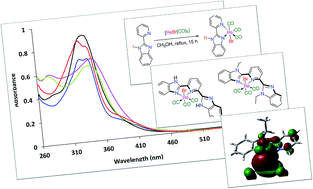Pyridylbenzimidazole based Re(i)(CO)3 complexes: antimicrobial activity, spectroscopic and density functional theory calculations†
Abstract
fac-[ReBr(CO)3(L1,2)] L1 = 1-ethyl-2-(pyridin-2-yl)benzimidazole (1) and L2 = 1-[(pyridin-2-yl) benzimidazole]-propyl-sulfonic acid (2), fac-[Re2Br2(CO)6L3] (3) L3 = 1,1′-(hexane-1,6-diyl)bis[2-(pyridin-2-yl)1H-benzimidazole] and fac-[ReBr(CO)3(L4,5-κ2N1N2)] (L4 = 2,6-bis(benzimidazol-2′-yl)pyridine (4) and L5 = 2,6-bis(1-ethyl-benzimidazol-2′-yl)pyridine (5) were synthesized and fully characterized using different spectrocopic and analytical tools. The spectrocopic data showed coordination of L1–3 to fac-ReBr(CO)3 via the benzimidazole and pyridine N-atoms. For 4 and 5, the absence of a two-fold axis of symmetry for L4,5 in the 1H NMR spectra reflect the κ2N1,N2 mode of coordination. The electronic properties of 1–5 were investigated by time-dependent density functional theory calculations in the singlet and triplet states. The ligands and their Re(I) complexes were assessed for their potential antimicrobial activity. Compound 5 was screened against non-malignant cell line (noncancerous human embryonic kidney cell line (HEK293)) as well as evaluated for its blood compatibility.



 Please wait while we load your content...
Please wait while we load your content...